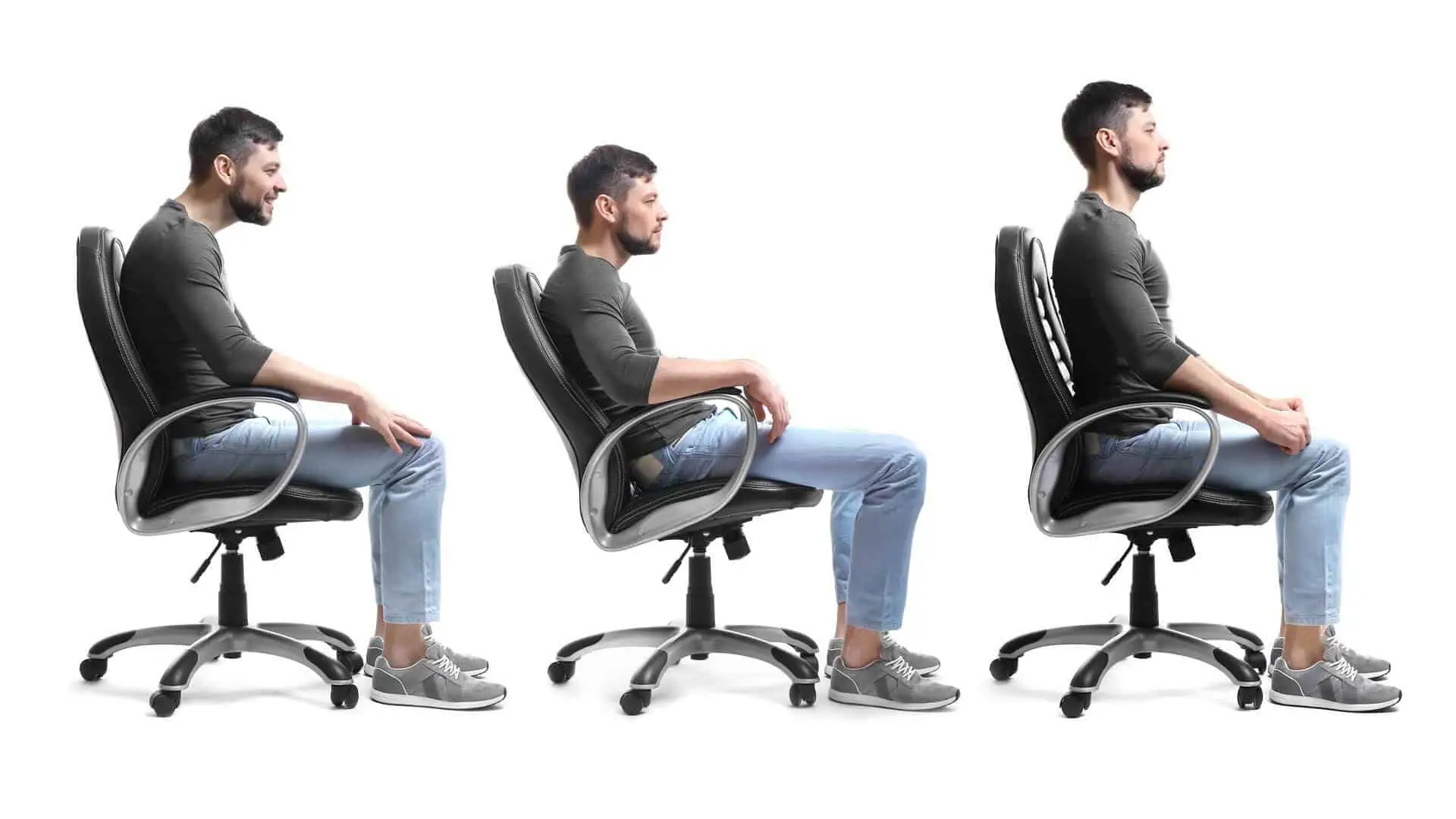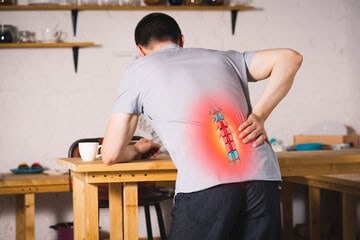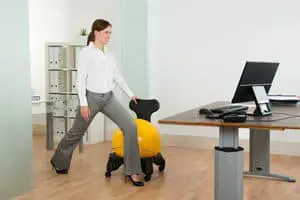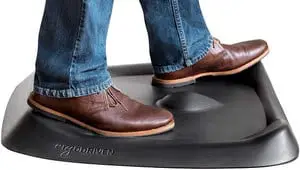Did you know that about 5 to 7 percent of the population suffer from spondylolisthesis? While it’s true that non-surgical treatment can relieve your symptoms most of the time, spondylolisthesis can often cause lower back pain. This can cause discomfort, especially when the person works while sitting down most of the time.
So, how to sit with spondylolisthesis?
The best way to sit with spondylolisthesis is sitting tall in a perched posture, where the pelvis is tilted slightly forward, opening the hips and chest to facilitate a more neutral posture. Additionally, wearing a back brace can take some of the pressure away from the spinal column and reduce the pain.
However, there are plenty of factors to consider when learning about how to sit properly with spondylolisthesis. It’s paramount to educate yourself to keep your spine safe as it tries to recover from the fracture, especially when you are required to sit at work. Read on to learn more on how to reduce the pain.
All content and media on Office Solution Pro are created and published online for informational purposes only. It is not intended as a substitute for professional medical advice and should not be relied on as health or personal advice. This post may contain affiliate links.
What Is Spondylolisthesis?
Spondylolisthesis, according to Cleveland Clinic, is a spinal condition that causes lower back pain. It happens when one of your vertebrae (spinal bones) slips forward onto the bone directly beneath it. While it can be very painful, both non-surgical (therapeutic) and surgical treatments are effective against spondylolisthesis.

What Causes Spondylolisthesis?
Overextending the spine is one of the main causes of spondylolisthesis in most people. However, causes of spondylolisthesis vary based on age, heredity, and lifestyle.
Children may suffer from this condition because of an injury or a birth defect. Rapid growth during adolescence may also be a contributing factor. On the other hand, adults can suffer from spondylolisthesis due to wear and tear on the spine and disks (the cushions between vertebrae).
What Are The Symptoms Of Spondylolisthesis?
According to Healthline, the symptoms of spondylolisthesis may vary. People with mild cases may not have any symptoms. However, people suffering from severe cases of spondylolisthesis may not be able to do simple activities, including sitting. Some of the most common symptoms of spondylolisthesis are:
- Back and legs stiffness
- Lower back pain pain
- Lower back tenderness
- Hamstring and buttock muscles tightness
- Thigh pain
Moreover, you may suffer from spondylolisthesis if you have difficulty walking or standing for long periods of time. You may also feel pain when trying to bend over.
How To Sit With Spondylolisthesis
Unfortunately, many people suffering from spondylolisthesis have jobs where they are seated most of the day, whether they work from home or at the office. Though you may not think about it, there are simple ways to sit properly and minimize discomfort while you recover from spondylolisthesis. Here’s how:
1. Start By Understanding Neutral Spine Position
The first and most important thing to remember when sitting with spondylolisthesis is to understand the neutral spine position, something that many people neglect, especially when working behind a desk.
The optimal sitting position is achieved when the spine is neutral, creating a natural S shape whilst positioning the legs so your feet are flat on the floor, with feet and knees roughly hip-width apart, and maintaining correct arm posture. Ideally, your arms should form a 90-degree angle with the desk.
Remember, sitting puts a tremendous amount of pressure on your spine, so it’s paramount to alternate sitting positions often. If possible, get up from your desk to walk or stretch several times an hour. Doing so might sound simple, but it works wonders for your back health in the long run.
However, while it’s important to change positions frequently, the Mayo Clinic advises against crossing your legs because it encourages you to slump or hunch over.
When you are sitting in a neutral spine position, your shoulders should be relaxed and pulled back to reduce tension from forming in the area. During sitting, your chair should ideally provide support in the lower back and mid-back areas. If that isn’t the case, then you need an ergonomic chair, which brings us to…
2. Use Ergonomic Chairs When Sitting

The best ergonomic office chair can help you to sit with proper posture, removing pressure from your lumbar spine.
Most office chairs are not designed to support the human spine. If you work in front of a desk daily, then the least you can do to help your body recover is to invest in a top-tier ergonomic office chair. Not only do these chairs help keep your spine neutral, but they also provide additional support for your lower back.
It doesn’t matter how conscious you are of how you sit because, after some time, your body will slouch. An office chair that is not built with ergonomics in mind can force you to sit in a poor position, resulting in unwanted pain in the back and slowing down your recovery from spondylolisthesis.
3. Wear a Back Brace to Support Your Spine
According to Spine Universe, it can be difficult for your spine to provide proper support because the vertebrae are out of alignment when one is suffering from spondylolisthesis. This causes your muscles to work overtime, which leads to pain and fatigue. One way to support your back is to wear a back brace.
Doctors often recommend a back brace as part of a non-surgical treatment because it can take some of the pressure away from the spinal column. The objective is to give you some pain relief as the back brace compresses your abdomen while keeping your spine safe as it tries to recover from the fracture.
We’ve found one product made by a company that specializes in back braces designed to help with spondylolisthesis on Amazon called BraceAbility. They come in six different sizes to accommodate both men and women. Not only does it protect the spine well, but it’s also very lightweight and breathable too.
4. Do Physical Therapy Consistently
After a complete examination and evaluation, your physical therapist should provide you with a personalized home exercise program, which includes targeted exercises to strengthen your abdomen (belly) and back and to decrease pain due to spondylolisthesis. Daily exercises often relieve pain after a few weeks.
According to Healthline, the exercises mainly consist of lumbar flexion exercises, core stabilization exercises, and exercises or stretches for the muscles of the back, hamstrings, and hips. Low-impact exercise such as cycling or swimming is also recommended to promote healing and decrease pain.
It’s important to be diligent with physical therapy and do the exercises consistently. Doing so can speed up your recovery and prevent reinjury in the long run.
Additionally, eat a well-balanced diet to keep your bones well-nourished and strong. Excess weight puts added stress on your lower back, so it’s important to maintain a healthy weight.
Final Words
And there you have it, a simple guide on how to sit with spondylolisthesis. Start by investing in a chair that supports the lower back, then employ the correct way of sitting. Moreover, you can wear a back brace for additional support. If the pain persists, talk to your healthcare provider about ways to manage your pain.









